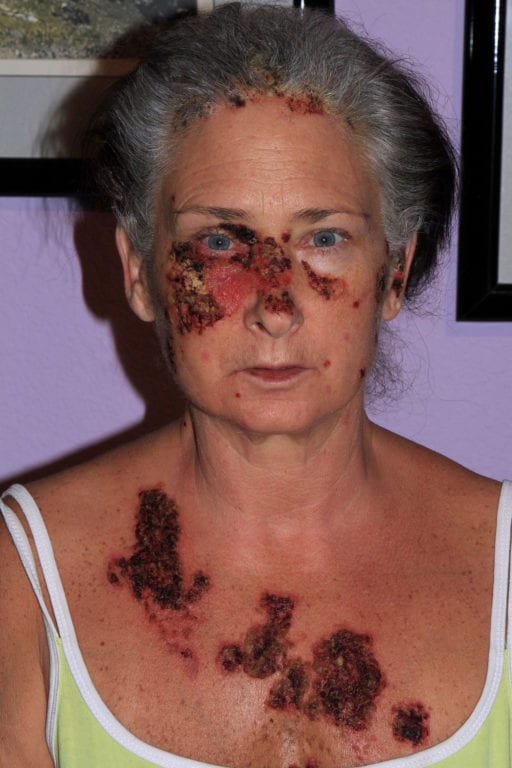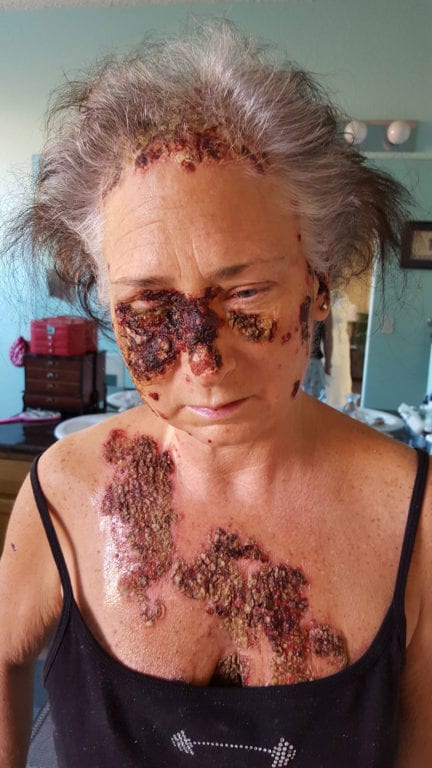This story contains images of severe lesions and blistering.
On the weekend of October 12-14th of 2018, Patient Worthy had the privilege of attending the International Pemphigus & Pemphigoid Foundation’s 21st annual patient conference in Durham, NC. While there, we spoke with Kelly Calabrese, a patient who experienced a very severe case of pemphigus vulgaris. She had been in remission for close to a year, and she is hoping that she will never relapse again.
About Pemphigus
Pemphigus vulgaris is the most common form of pemphigus, a rare disease that causes blisters to form on the skin and mucus membranes. Pemphigus is an autoimmune disease in which the immune system creates autoantibodies. This disease is more common in women and in people of Ashkenazi Jewish descent, revealing that people with certain genetic variants are more likely to get pemphigus. Symptoms include blisters that break and form into lesions and open wounds. They often first appear in the throat and mouth, making eating and swallowing extremely painful. Other surfaces where blister may occur include the eyelids, genitalia, anus, and esophagus. Diagnosis of the disease can take a long time. In the past, this disease was often lethal as the open wounds that form can become easily infected, and the painful nature of mouth lesions can prevent patients from eating normally. Click here to learn more about pemphigus.
Kelly’s Story
Kelly’s story begins in the summer of 2014, when she began to experience an off taste when eating, almost like plastic. When she would blow her nose, the mucus often had a reddish hue. Eventually, it began to feel as if there was plastic in her mouth and throat. These were most likely Kelly’s first blisters. By March of 2015, Kelly knew that something serious was wrong when blisters began to appear on her scalp.

Unfortunately, many of her earliest doctor’s visits were not particularly helpful. No one was able to give her a solid explanation of what she had, but she finally got a diagnosis of pemphigus in May and was sent home with corticosteroids. However, this medication had basically no effect. She continued other treatments, but nothing was working. Kelly’s condition began to decline severely.
Over the next few months, she was basically bedridden. It was painful to do basically anything, and eating was especially hard. Blisters were now appearing on her chest, face, and scalp. As a result of this, she began to drastically lose weight. At this point, Kelly genuinely felt like she was dying; she could tell that her body was shutting down. By December, with little hope left, Kelly was prescribed rituximab, which since that time has become the only FDA approved treatment for pemphigus vulgaris. It was the first medication that really worked. She took the drug biweekly for a period of five months. For eight months, her disease was suppressed, but not entirely in relapse. Nevertheless, the she felt better than she had in a long time.

Thankfully the improved Rituxan treatment helped Kelly’s body to recover quickly from this painful disease and is in full remission. She took the treatment over six months, a total of 13 cycles. Since December 2017, Kelly has been in remission, and she hopes to stay that way.
”For those suffering with any kind of debilitating illness, hang in there…be vigilant, research, stay on top of things, and help the doctors help you…good luck and best wishes.” – Kelly Calabrese






